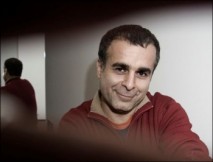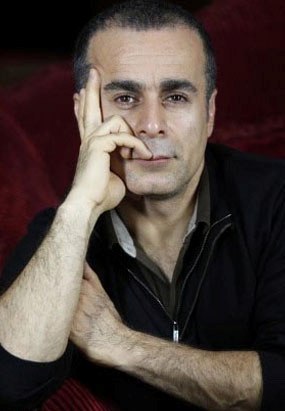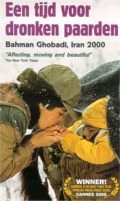Interviews / Interview Bahman Ghobadi IFFR 2007

IFFR 2007: Interview met regisseur Bahman Ghobadi
door Jaap Mees

NFTVM-verslaggever Jaap Mees hield een interview met de regisseur van onder meer Time for Drunken Horses, Turtles can Fly en Half Moon.
The following 25 minutes interview I had during the just finished International Film Festival in Rotterdam, with the Kurdish filmdirector Bahman Ghobadi. With the help of an excellent interpreter Behnam Taebi.
Ghobadi made the beautiful and moving film A Time for Drunken Horses (2000) about 5 young children, who struggle to survive on their own in the barren mountainous area of the Kurdish part of Iran. They lost their mother and their father is away to make a living from smuggling. The children also have to look after their handicapped brother, who looks like a little old man. He is desperately in need for an operation to prolong his life.The title of the film is derived from the fact that the horses, they need for transporting goods are given vodka, to keep them going in the harsh winter conditions. Turtles can Fly (2004) deals with children in a refugee camp on the borders between Iraq and Turkey, just before the American invasion in Iraq in 2003. Satellite, the boy-leader of the children, who are often without arms or legs, teaches them to dismantle landmines to make a living. Half Moon (2006)is about an old musician, Moma, who gathers a group of musicians to go to the Kurdish part of Iraq. They travel in a ramshackle old bus, through the mountains to perform the concert of their life, just after the fall of Saddam Hussein. Things go wrong when their female singer, who they have to hide in the bus, is being arrested.
Jaap Mees: 'I saw your film, "A Time for Drunken Horses" in New York in 2000 where I had a documentary in a festival. A guy at the reception of my hotel, who was a Kurd himself, said: I saw a beautiful film the other day, you must go and see it. I went to a small art house in Greenwich Village and was very moved by your film. Later I saw Turtles can Fly and yesterday Half Moon.
How did you find the story for Half Moon?'
'I was requested to make a film in honour of the 250th Anniversary of Mozart. An idea of the American opera-director Peter Sellars to make something in the spirit of Mozart for the New Crowned Hope Festival in Vienna. Producers were Simon Field and Keith Griffith for Illumination Films. There was not much time to finish the film, I wrote a synopsis in one week, during the day I was looking for the actors on the street and in the afternoon I was looking for the locations. At night I tried to write. The week after, we were starting shooting already. During the day we were shooting, and in the afternoon we were editing and preparing the soundtrack. The story has been born during the shooting, very much based on the reality of the society. It was something I experienced my self during the making of Turtles Can Fly, I was waiting for 7 months to get permission to shoot. The whole process from beginning to subtitling lasted 4 months. When it was finished I didn’t think it was my fourth feature. Now I do.'

Why did you have to work so fast?
'I had to hand in the film for a certain deadline, when I started shooting I had 6 weeks before the winter was ending .There was not much snow, which was necessary for the continuity in the film.'
What I didn’t understand in Half Moon, why was the female singer not allowed to sing, why was it necessary to hide her in the bus?
'The singer is not allowed to sing for men according to Islamic rules. Two women singing at the same time is forbidden too. I don’t understand why.'
At the end of the film there is a second beautiful female singer, who appears out of nowhere, is she real or is she an angel?
'She is just somebody to help the old musician Moma. It doesn’t really matter or she is coming from Heaven to help them or she is just a woman from Earth. The point is she is there to help them to reach their goal.'
About your style in all of your films, you hardly know or it’s documentary of fiction, because the films are so true to life.
'About 70% of my scripts are being realised during the shoot. I am very conscious of the environment I am working in and I’m constantly scanning the surroundings for things I can use the day after. That’s the reason it seems all like a documentary. Cinema is believing, you must believe in the person you are playing, the actors, the story, this is crucial for the cinema I‘m trying to accomplish. That’s why I go to real locations, look for real actors in real communities, I try to let them act as in their own lives. I try to avoid the latest technology of sound effects and other special effects.'
Talking about technology, it was very strange to see mobile phones and even lap-top’s in Half Moon situated in this raw, isolated mountainous environment?
'I was talking about using modern techniques in the filmmaking, but your question is about ways of modern communication in the story. That’s just reality, people are very familiar with modern technique nowadays.'
I read that you worked as an assistant for the Iranian filmmaker Abbas Kiarostami (Taste of Cherry, Through the Olive Trees).
'I have been helping Kiarostami on a feature, when he was looking for someone who could speak Kurdish, In fact, I worked more as a production manager than as an assistant. At that moment of filming, I realised that this wasn’t the kind of cinema I was looking for. Nevertheless, I liked very much some of his work. He taught me something important, that you must make a movie passionately, don’t think of anything else when you are shooting.'
Would you like to make films outside of Kurdistan in the future?
'The reason that I make films in Kurdistan is that I’m familiar with the language and culture. It’s an innocent nation which has been suffering a lot over the last years.(think about the chemical attacks executed by Saddam Hussein, JM). I see it almost as my duty and responsibility to introduce Kurdish cinema to the audience.'
A question about the amazing children in your first two films, A Time for Drunken Horses and Turtles can Fly. How do you work with them?
'I am searching extensively among about 1000 children, I make photo’s of them and I look carefully at their faces, which show you a lot of the history and the suffering they have gone through. Than I make a selection. For Half Moon, I found Moma, the old musician and ten other characters on the streets. One or two have acted in my earlier films, like the bus driver for instance.
But the children hardly look as children anymore?
'You know, the handicapped children in Turtles Can Fly laughed much more than I did. During shooting I was sometimes very much discouraged about life and even had suicidal thoughts, but the children gave me back my joy of life.'
You make films of people who suffer in hard living circumstances, now you are here in the luxurious building (De Doelen) of an international film festival. It must be such a contrast.
'I don’t think so, the suffering here in the West is almost as bad as in Kurdistan. It’s more a mental suffering, even not having any pain could also cause suffering. The people I worked with know more how to enjoy life and to get from life what is has to offer.'
I’m writing for the New Film and TV Makers site in Amsterdam, many of them are going to make their first feature at some stage. What would you advice them?
'I would advice them to open new and different windows, make something only you can make.'

